North Dakota Highway Patrol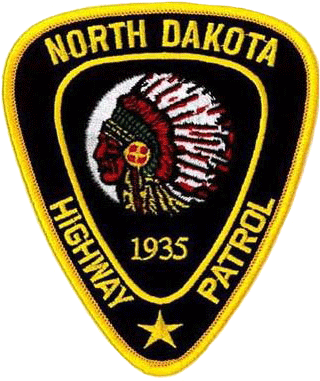
North Dakota Highway Patrol
The North Dakota Highway Patrol was created in 1935 with a responsibility to enforce motor vehicle law on the state highways. Five patrol officers were sent to attend the Minnesota State Highway Patrol training program that year.
Upon completion of the training, the officers had to travel up to Duluth from St. Paul to pick up the five 1935 Buick coupes purchased for them which arrived by freighter from Michigan, and drive them back to Bismarck.
Those Buicks were eventually joined by two Fords, a Plymouth, a Lafayette and a motorcycle. 248,000 miles were patrolled by the NDHP from 1937 to 1939.
1951 was the year the NDHP adopted their symbol as Red Tomahawk, a Teton Dakotah (Sioux) Indian who lived on the Standing Rock Indian Reservation near Mandan.
His distinctive and impressive profile has been associated with the agency ever since. Once limited to only matters of traffic law and operator licensing, the scope of the NDHP's policing capabilities began to expand in the 1960's including the enforcement of criminal law on highway right-of- ways in 1967.
In 1983, there was a consolidation of the Truck Regulatory Division of the Highway Department into the Highway Patrol. The NDHP became an nationally accredited law enforcement agency (CALEA) on July 29, 1989. In 1992, a Canine Unit was introduced. Today, the NDHP has over 130 sworn Troopers providing safety and security of the residents and visitors to the Peace Garden State.
The license plates issued to the NDHP's first 5 patrol vehicles were government service "OFFICIAL" plates numbered 461 through 465.
The plates were made of embossed steel and colored orange over black. The prefix ND was stacked vertically at the left side of the plate and OFFICIAL obliqued to the right of the prefix followed by the number and 1935 stacked vertically on the right.
An embossed tab with the words STATE PATROL ran the horizontal length of the plate and was affixed to the top mounting holes, but in a dark over light color combination according to period photographs.
In 1936 the same format and material was used, but the colors were black over orange. The STATE PATROL horizontal strip was used again and fastened the same way as they were the year prior. This is when NDHP numbers began in the 200 series. Plates number 201-205 verified.
1937: Same format and materials. Green over white. Serial bloc 201 to 210 verified.
1938: Same format and materials. Black over yellow. Serial bloc 201 to 205 verified
In 1939, a whole new layout was used. The plates were made of embossed steel and colored red over white. STATE PATROL was embossed above the top line border of the 6" x 12" plate. This portion above the border looked like a supplementary strip but was actually an integral part of the plate. Below the upper border was NORTH DAKOTA embossed below the upper mounting holes. 1939 was embossed and stacked vertical on the right side of the plate. TAX EXEMPT was embossed at the bottom above the lower mounting holes.
Three digit number in 200 series was embossed in the center.
Numbers 201-210, 212, 214-15 and 233 verified.
There is nothing known about NDHP license plates from 1940 to 1946.
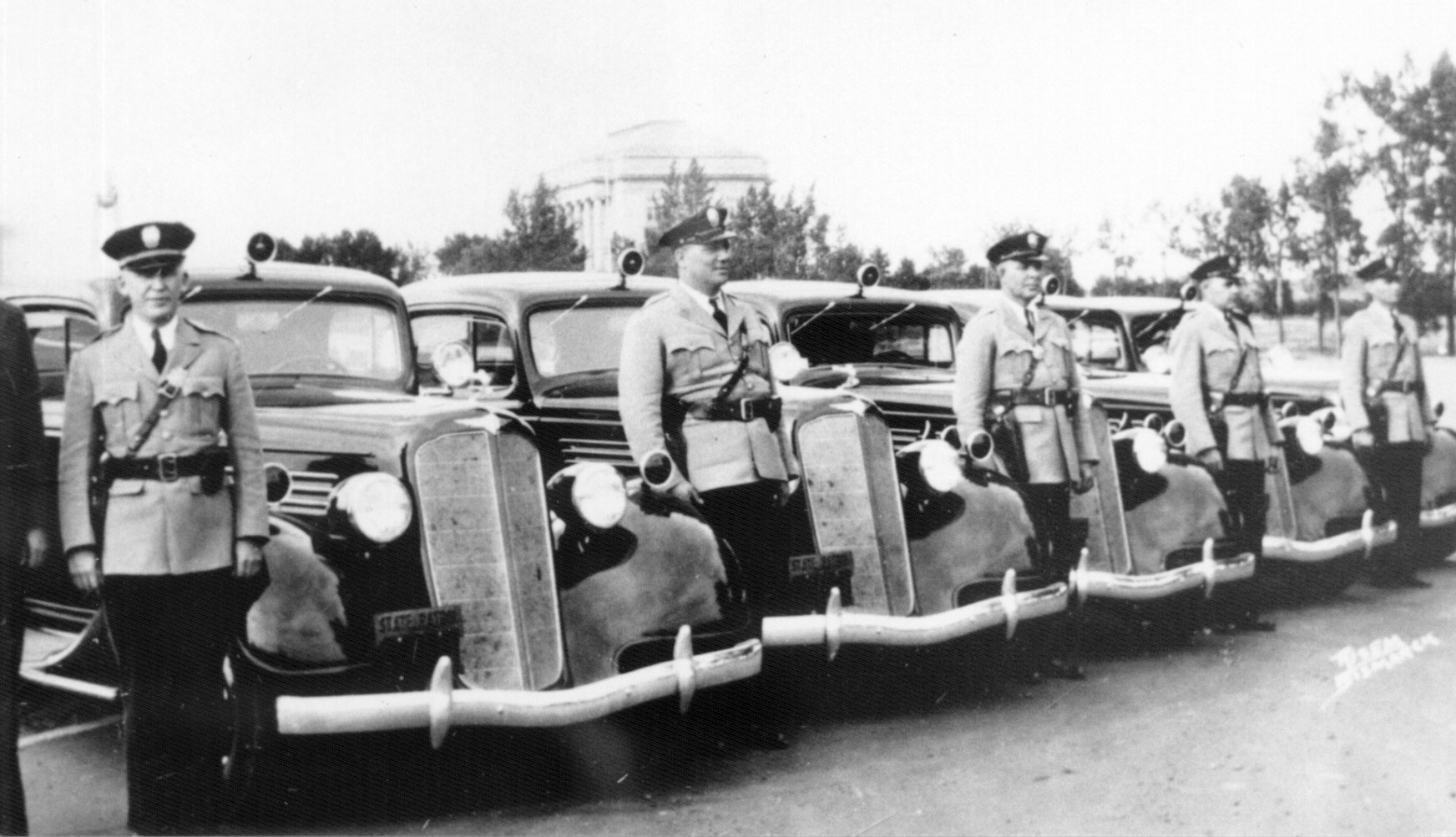

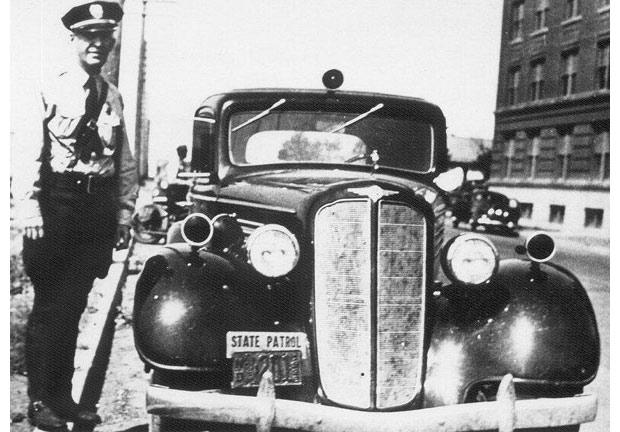 1936 ND OFFICIAL plate with STATE PATROL strip.
1936 ND OFFICIAL plate with STATE PATROL strip.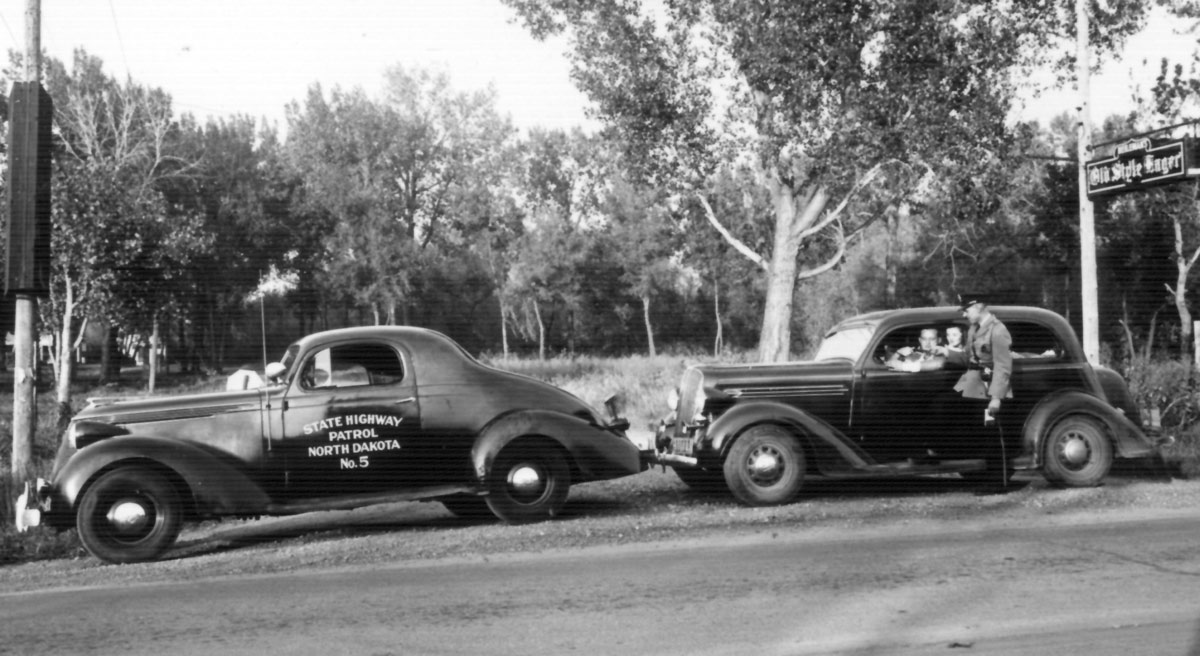
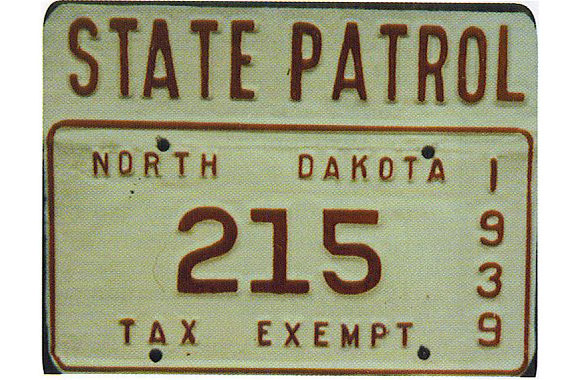 1939 issue.
1939 issue. 
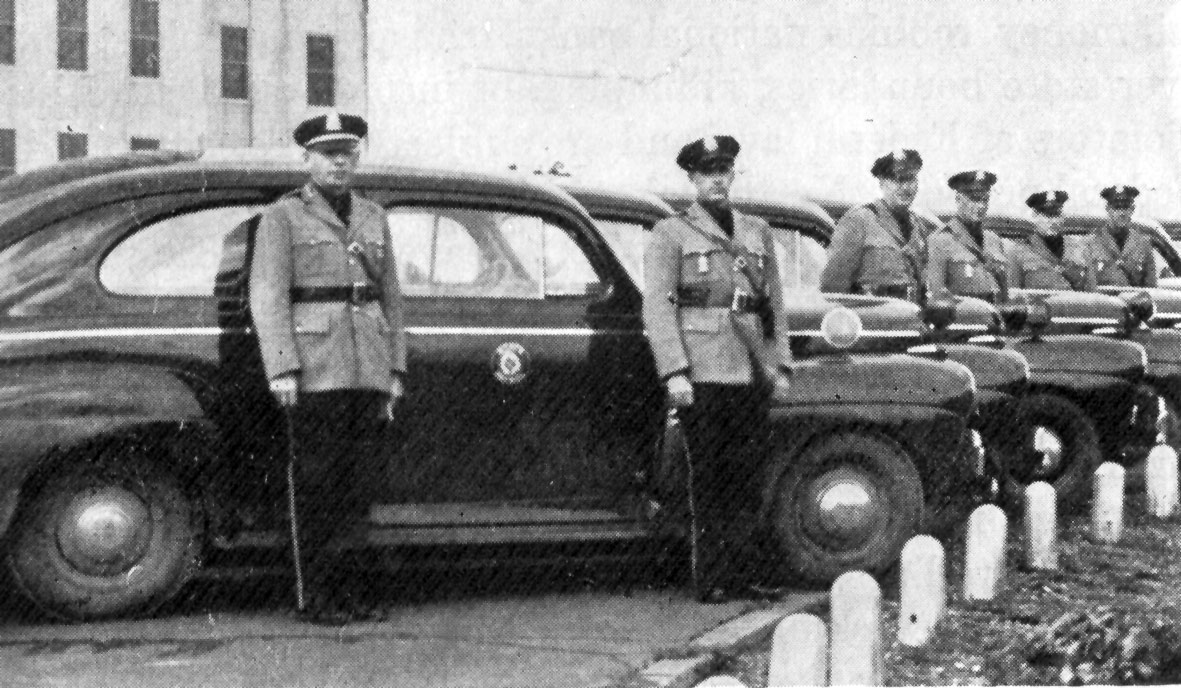
In 1947, the return of the STATE PATROL strip this time in galvanized steel on the state OFFICIAL license plate continued.
The plate measured 5 1/2" x 11 3/4" and colored black over yellow. The prefix ND was stacked vertically at the left side of the plate and OFFICIAL obliqued to the right of the prefix followed by the number in the 200 series and 1947 stacked vertically on the right.
There is no other NDHP license plate information for 1948 through to 1950.
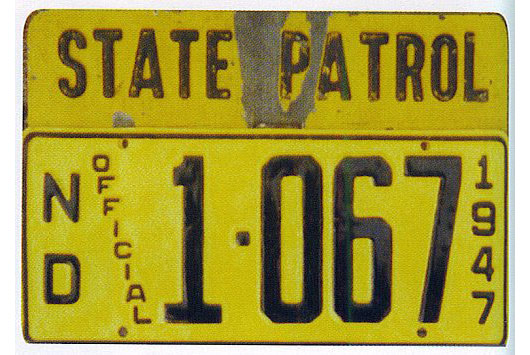 1947 ND OFFICIAL license plate and STATE PATROL strip.
1947 ND OFFICIAL license plate and STATE PATROL strip.
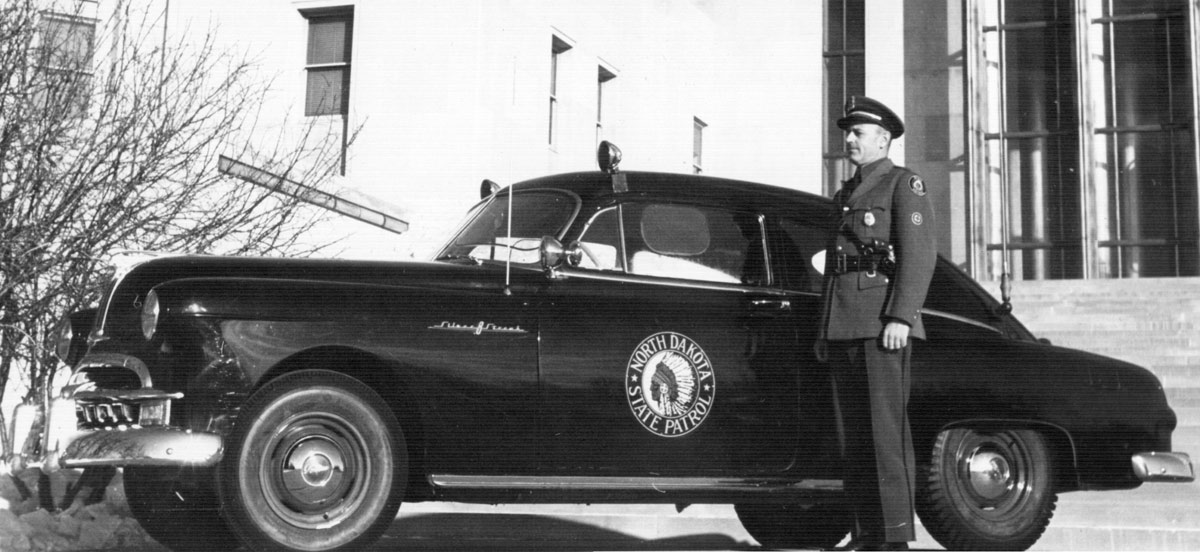
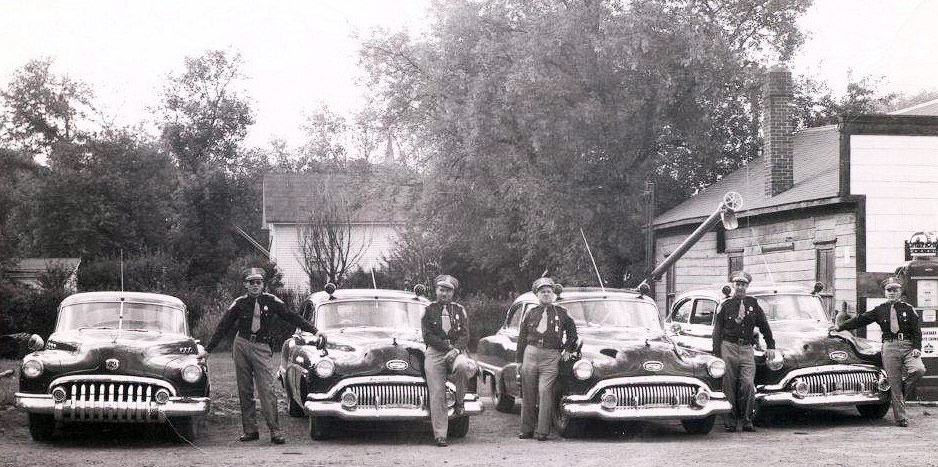
In 1951, the OFFICIAL state license plates used by the NDHP had changed. The plates were still made of embossed steel and measuring 5 1/4" x 11 3/4". They were colored white over black and were undated. NORTH DAKOTA was embossed along the top of the plate and OFCL was embossed in a vertical stack along the left margin of the plate. A number in the 200 series was embossed in the center. These plates were used through 1953.
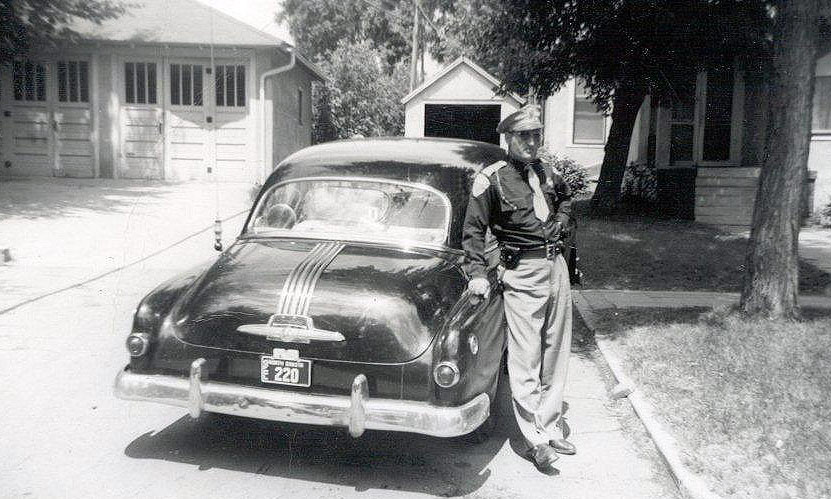
In 1954, dated OFCL plates returned for the NDHP. The embossed steel plates were now a little longer, measuring 5 1/4" x 12". NORTH DAKOTA 54 was embossed along the top of the plate. OFCL was embossed in a right oblique on the left margin and a number in the 200 series (201-242) occupied the center of the plate. The plates were colored white over black. During the year of 1954, NDHP Officer B.E. McLane was killed in a motor vehicle collision while on duty. This was the agency's very first line-of-duty death. As a tribute to him, the NDHP permanently retired his number 218. To this day, the number 218 is still not issued to any NDHP personnel.

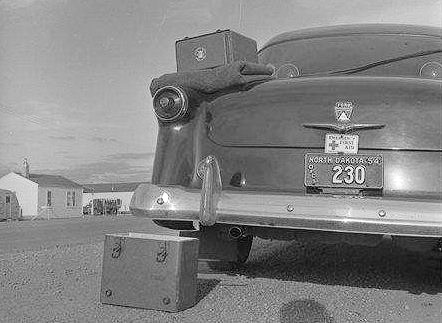 1954 (Courtesy Jim Benjaminson)
1954 (Courtesy Jim Benjaminson)In 1955, the 200 series numbers represented the badge number, radio number and license number for each assigned patrolman.
Number 200 was reserved for the Colonel of the NDHP.
It is not confirmed as to the color and formatting for the NDHP license plates from 1955 through 1957, but it can be assumed that the OFCL plates in the 200 series continued during that time. Unofficial records state that the colors during that time were:
1955 Yellow over black
1956 Blue over white
1957 White over blue.
Oddly enough, plate numbers 291 through 298 were reserved for high-ranking officers, unlike other agencies that reserved the lower numbers for their upper echelon.
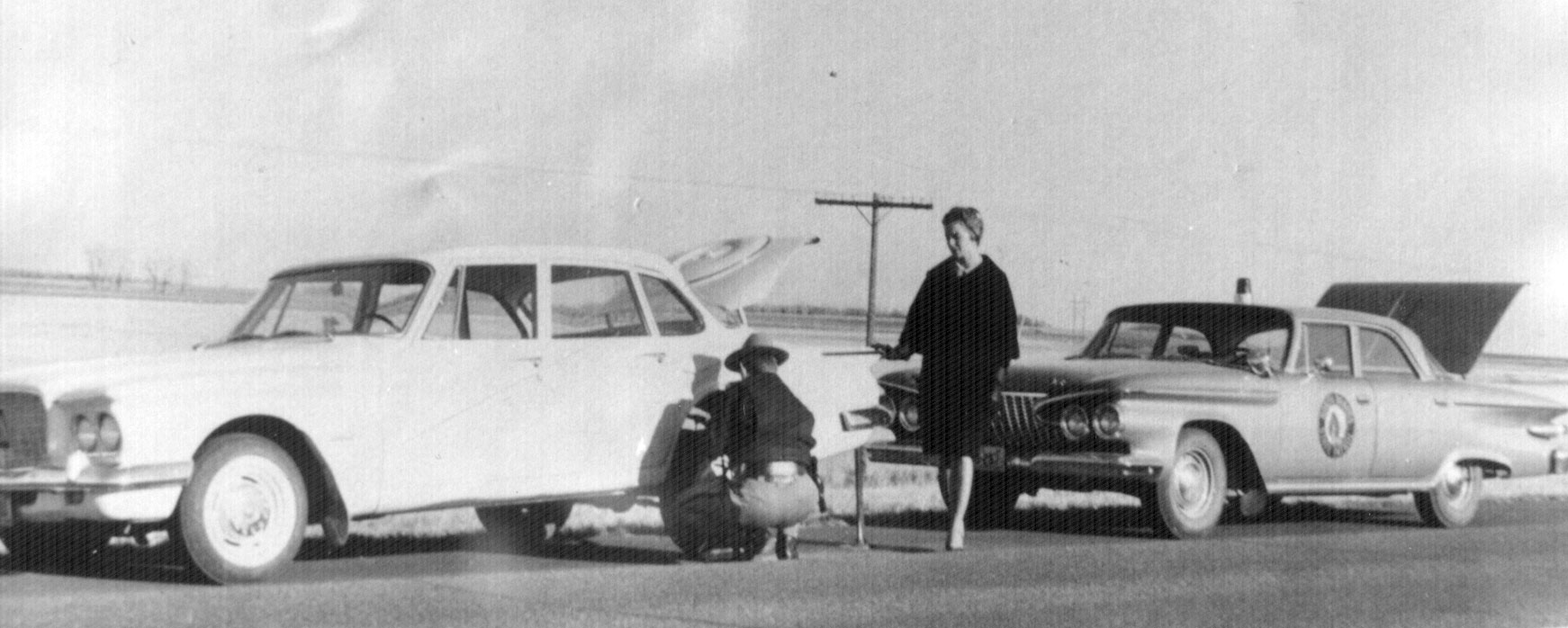
In 1958, the state of North Dakota issued a 6" x 12" green over reflective white license plate for all motor vehicles in the state. This was the first time that a reflective material was used on North Dakota license plates. The format had NORTH DAKOTA 58 embossed along the top of the plate just below the upper mounting holes. There were slots placed on either side of the 58 to accommodate validation tabs for subsequent years of usage. The slogan PEACE GARDEN STATE was embossed along the bottom of the plate and above the lower mounting holes.
For reasons still unknown, rather than continue with using North Dakota OFFICIAL license plates, the NDHP were issued PASSENGER series plates in the 30-2## series. What significance the 30 has, nobody knows, but the 200 series for badge and radio numbers continued. The state motor vehicle records show these plates as official use, however they appeared civilian in every other aspect.
For 1958, the numbers ran from 30-200 to 30-261 and 30-291 to 30-298 for upper ranks. These plates were revalidated by means of a metal year tab for 1959, 1960 and 1961.
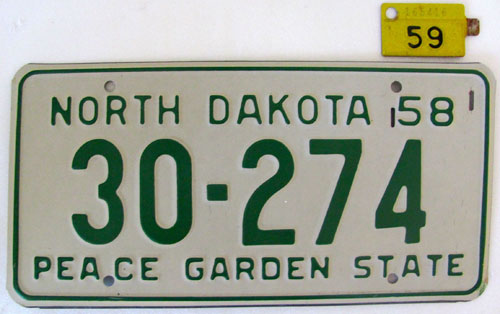 1958-1961 issue.
1958-1961 issue. 
A similar plate in format was issued for 1962, however these plates were made of embossed aluminum and the state name was abbreviated to N.DAKOTA. The colors were black over reflective white and the same 30-2## numbering system continued. Despite having a slot for a validation tab on the right side of the 62, the state opted to issue validation decals for 1963, 1964 and 1965. Patrolman numbers went up to 30-275 during this time.
Perfect on-duty photograph showing the 1962 issue plate seen below, courtesy of Jim Benjaminson.
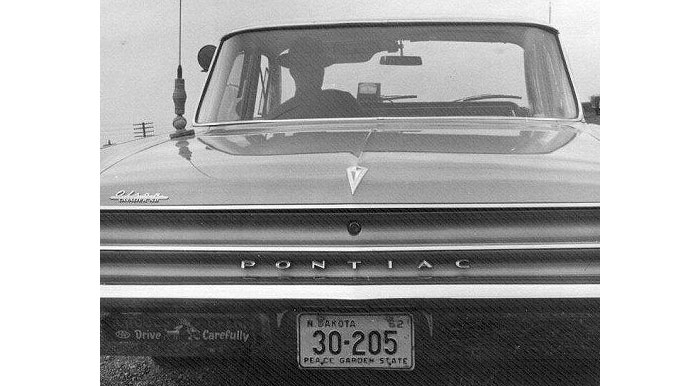
The same format, material and numbering system continued for 1966, however the color scheme was red over reflective white. They were validated through 1969 with annual decals.
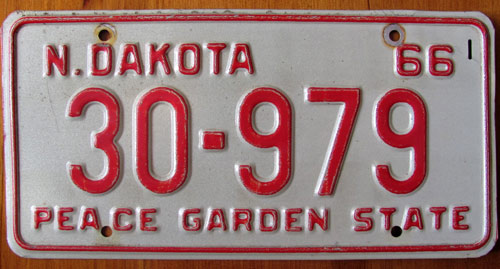 1966 issue.
1966 issue. 
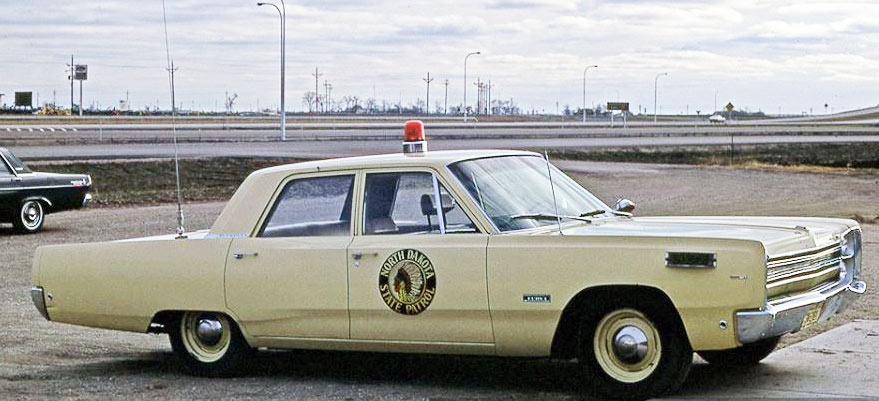 (Courtesy Willie Brown)
(Courtesy Willie Brown)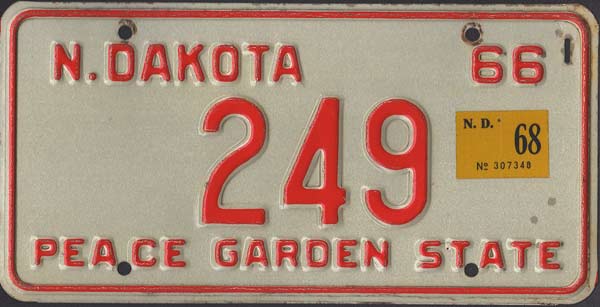 1966-1969 PERSONAL CAR issue.
1966-1969 PERSONAL CAR issue.

The same format, material and numbering system continued for 1970, however the color scheme was dark blue over reflective white. They were validated through 1973 with annual decals.
It was during this time and into the 1970's that NDHP patrolmen were able to register their personal vehicles with their badge/radio number.
As the example below can be seen, number 259 is the personal vehicle of the ND Highway Patrolman whose patrol car ran 30-259.
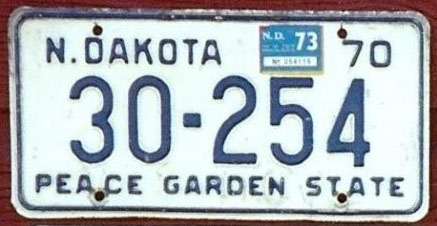 1970-1973 issue.
1970-1973 issue. 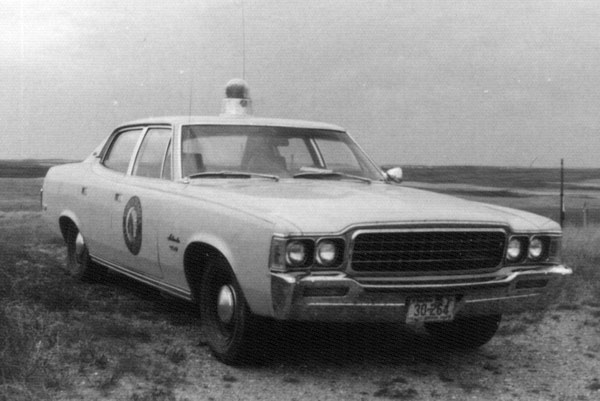 NDHP AMC Ambassador
NDHP AMC Ambassador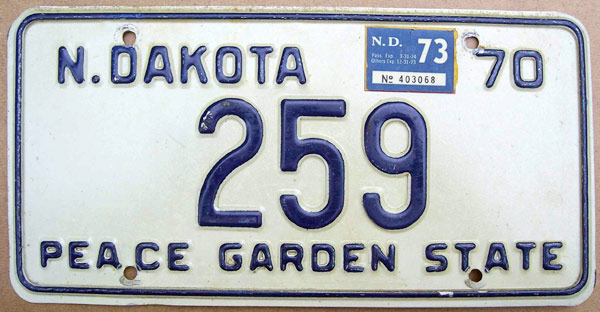 1970-1973 PERSONAL CAR issue.
1970-1973 PERSONAL CAR issue.
The same format, material and numbering system continued for 1974, however the color scheme was green over reflective white. They were validated annually through 1979. However, during this time, NDHP numbers had climbed well into the 300 series. As a result, a 1974 North Dakota OFFICIAL plate with number 327 was discovered from a collection of North Dakota Highway Patrol license plates with the same number but using the oblique OFCL prefix in lieu of the 30- prefix.
It can be surmised that these OFCL plates were run in the 300 series while plates in the 200 series continued to use the 30- prefix.
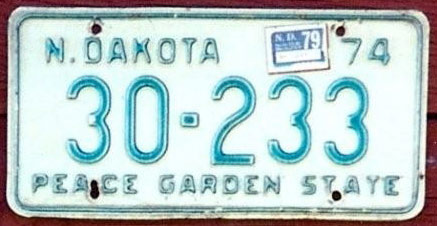 1974-1979 issue.
1974-1979 issue. 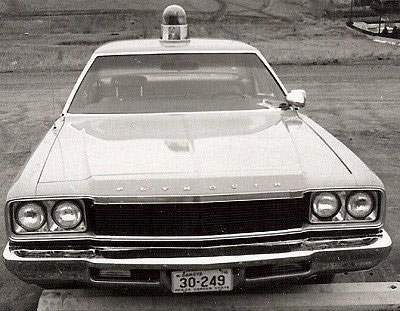
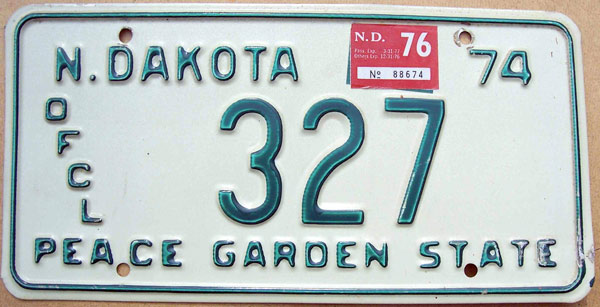 1974-1979 issue.
1974-1979 issue. 
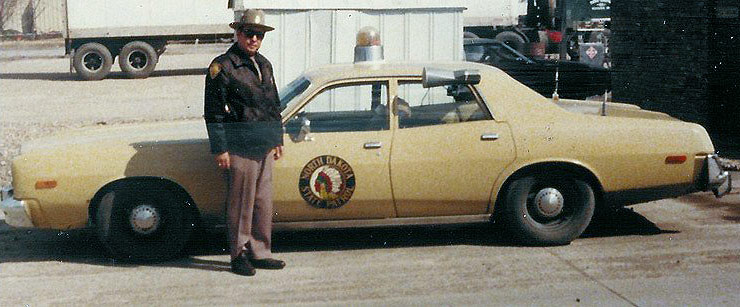
In 1980, the state of North Dakota "re-plated" for the entire state. The plate design allowed the state name to return in full. The plates were black over reflective white embossed aluminum. NORTH DAKOTA was embossed in the top center between the upper mounting holes. 80 was embossed in the upper right corner, and a curved indentation was embossed in the upper left corner to center future validation decals. PEACE GARDEN STATE was embossed along the bottom length of the plate above the lower mounting holes. NDHP plates had OFCL embossed and stacked vertically on the right followed by a G prefix (Government) and a three digit number in the 200 to 300 series.
Numbers in the G 270 to G 289 bloc were stated to have been issued to District Sergeants, G 290 through G 299 were issued to District Captains.
Numbers in the low G 300 series were stated to have been issued to officers of the original STEP (Selected Traffic Enforcement Program) "Flying Squad".
The Truck Regulatory Officers were absorbed into the NDHP in 1983.
These plates were run by NDHP with 1987 validation decals as they were expected to be used until that time.
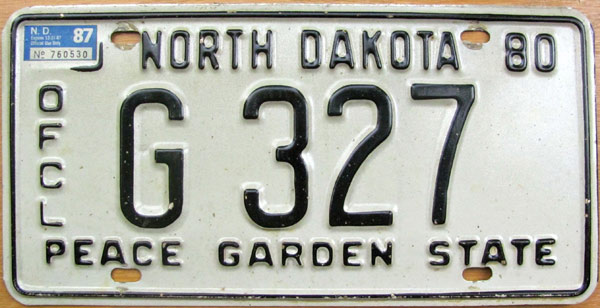 1980-1984 (1987) issue.
1980-1984 (1987) issue. 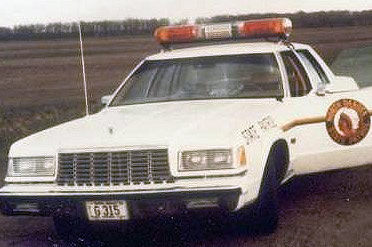 G 315 on a Dodge St. Regis
G 315 on a Dodge St. Regis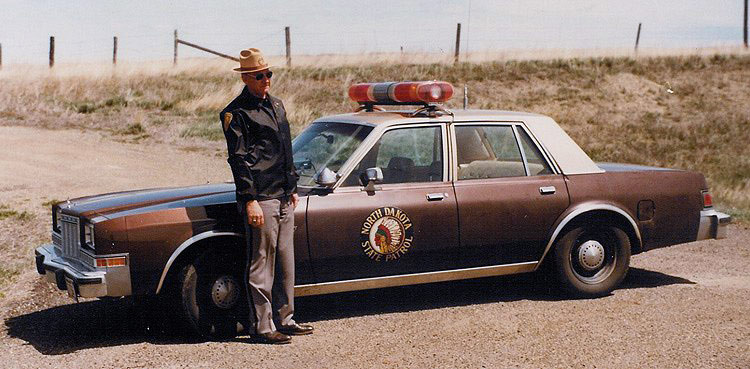
1985 saw the 50th Anniversary of the North Dakota Highway Patrol. In honor of this Golden Anniversary, the NDHP had arranged through 3M to manufacture and display very attractive full-graphic license plates to commemorate the milestone occasion.
The plates were made of embossed aluminum, with only the badge/radio number embossed. The colors were brown characters over reflective gold. The state slogan Peace Garden State was silkscreened in black from the top center to top right section of the plate and 50th Anniversary 1935- (over) 1985 screened in the same fashion on the lower section of the plate. The layout was crowned with a large full-color image of the agency's emblem occupying the entire left side of the plate.
The native indian chief seen in the center of the emblem is Tachankpe Luta, otherwise known as Red Tomahawk, a Teton Dakota. He was a renowned warrior but in later years was an Indian policeman. Red Tomahawk assisted in the capture and killing of Chief Sitting Bull when the U.S. Army had ordered his arrest in 1890. The arrest order was issued to prevent Sitting Bull from leading the Ghost Dance which was feared would stir-up the Indians following their surrender after the Custer massacre.
The stunning 50th Anniversary license plates were issued in triplicate. Two to be mounted on the patrol vehicle and one as a spare that was later given to the trooper as a souvenir of the occasion. Numbers issued were 200 through 350 with the exception once again of 218.
The number 1 plate was issued as a sample, and one with NDHP was retained for display at NDHP Headquarters.
Given the "attractiveness" of these license plates, the NDHP fastened these plates to their patrol cars with rivets in order to deter theft!
The plates were issued in January of 1985 and ordered removed and returned on December 31 1985.
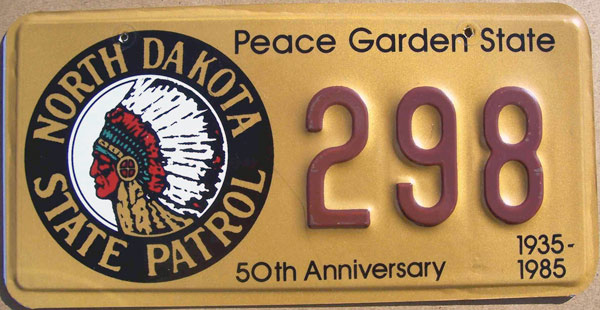 1985 50th Anniversary issue.
1985 50th Anniversary issue. 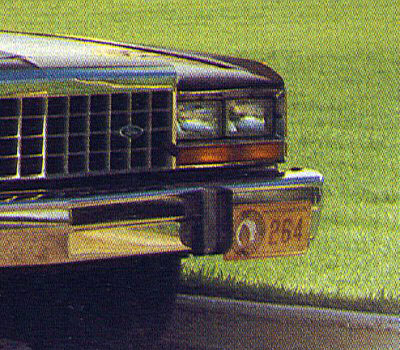
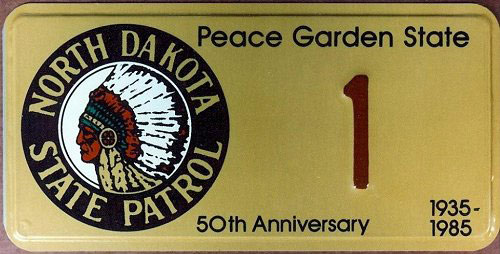 1985 50th Anniversary issue.
1985 50th Anniversary issue. 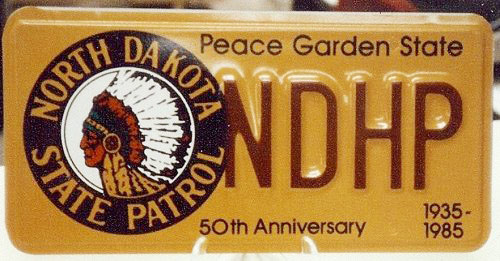 1985 50th Anniversary issue.
1985 50th Anniversary issue. 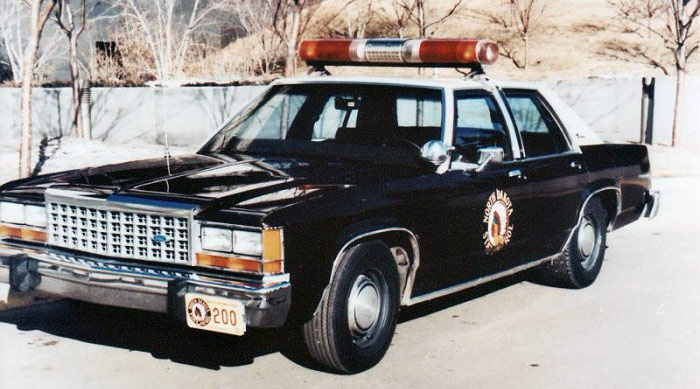
Shortly after the last of the 50th Anniversary license plates had disappeared from the NDHP fleet, a new graphic license plate was released for use by the NDHP.
Other motor vehicles in the state had begun displaying what were called the "Teddy Roosevelt plates" in late 1984 and 1985 while the NDHP were running their 50th Anniversary plates. They were offered as "extra cost" optional plates to North Dakota motorists.
The NDHP opted to use these plates on all of its marked patrol vehicles.
Interestingly enough, the North Dakota governor of the day, Allen Olson decided to have a public contest to design the state's new license plates when he took over from his predecessor. Six or seven designs made the final cut, and balloting took place in ND newspapers to decide which design would prove successful. In what some folks may deem political glad-handing, the Governor decided to lump aspects of all final submissions into one crowded design as seen on this final outcome.
By trying to please everyone, he apparently pleased no one with this "busy" layout which limited the plate to only 5 characters. Images include President Teddy Roosevelt himself who used to ranch in ND back in the 1880's, a highway representing the two interstate systems in the state,the state capitol, Union troops on horses, and a monument. Aside from this arguably poor design, Governor Olson's tenure in office was fraught with other bad decisions, he never saw a second term and moved out of state.
These plates in the HP2## and HP3## series were issued to the NDHP until the end of 1987.
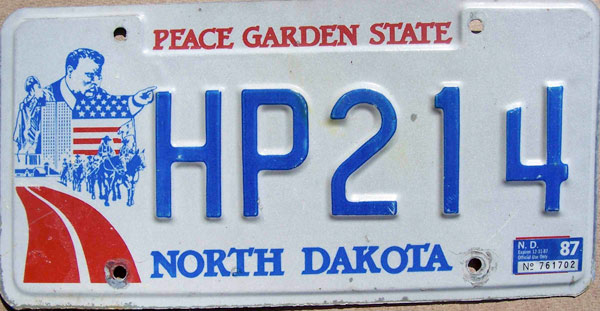 1987-1988 issue.
1987-1988 issue. 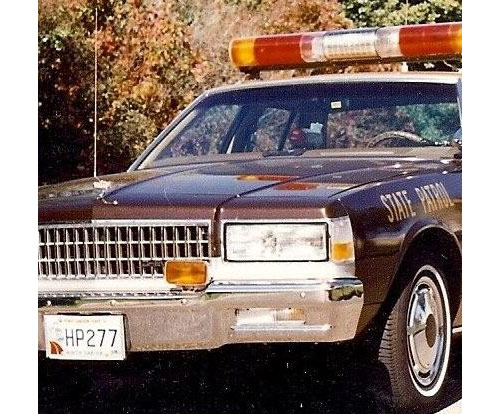
In January of 1988, the state of North Dakota began preparing for its state centennial to take place the following year. As part of the preparation for this occasion, yet another new license plate design was launched.
The North Dakota Centennial plate had embossed black characters over a reflective background of blue fading to white in the center and fading back in to gold towards the bottom. PEACE GARDEN STATE was silkscreened in black small font at the top center of the plate. A stylized black silkscreened banner with CENTENNIAL in white took up position in the center position of the plate just below the upper mounting holes. Another silkscreened black banner ran the horizontal length of the plate just above the lower mounting holes with 1889 NORTH DAKOTA 1989 in white inside the banner.
Plates were validated annually through 1993 with OFFICIAL USE ONLY validation decals.
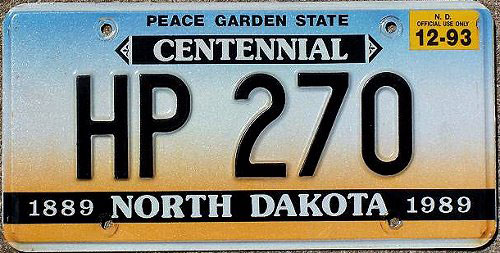 1988-1993 issue. Centennial base.
1988-1993 issue. Centennial base.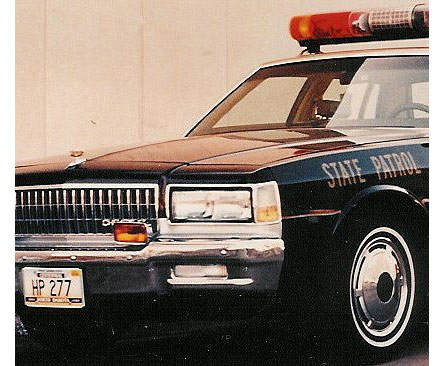
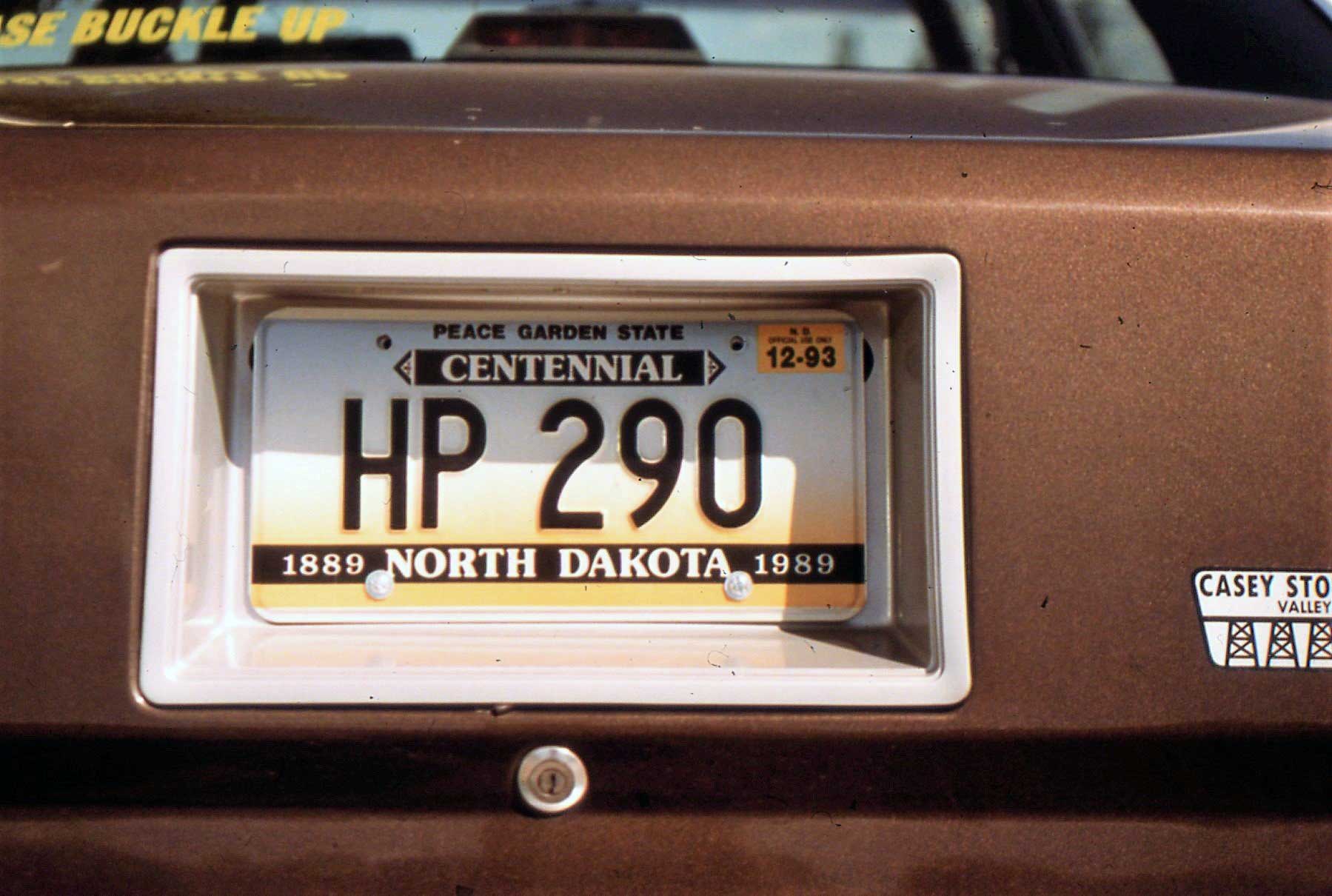 (Courtesy Jack McGee)
(Courtesy Jack McGee)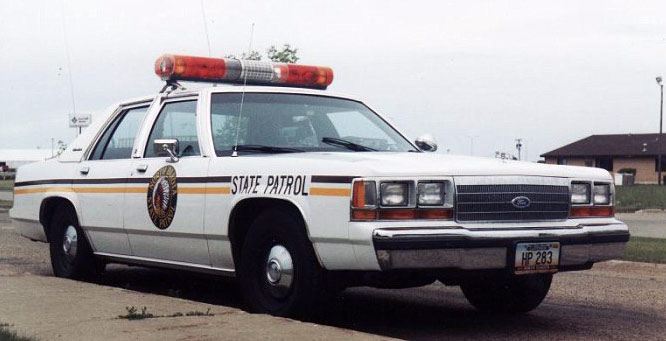
In 1993 a new license plate was issued for North Dakota. These plates were known as the "bison base" or "Discover the Spirit" base.
The plates once again had black embossed characters in the HP 2## and HP 3## series. The plate featured a reflective blue sky fading toward the center to white over the grey silhouette of a mountain range. The slogan "Discover the Spirit" is silkscreened in white on the upper center of the plate. Below that is gold colored pasture with a brown bison screened to the left bottom corner and 3 sprigs of wheat tops below a black banner centered at the bottom of the plate with NORTH DAKOTA inscribed in white. PEACE GARDEN STATE is silkscreened in brown at the very bottom center of the plate.
These plates were validated annually until 2001 with OFFICIAL USE ONLY annual decals which expired at the end of every December.
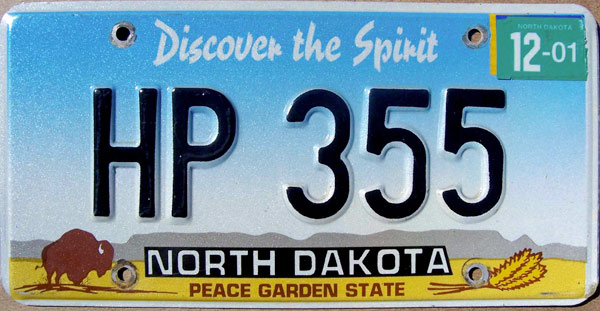 1988-2001 issue.
1988-2001 issue. 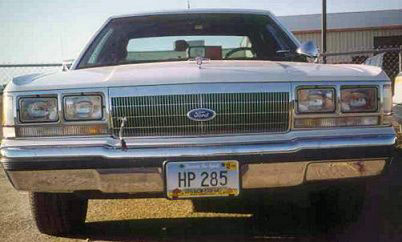 1988-2001 issue with 2000 validation decal.
1988-2001 issue with 2000 validation decal.In 2002, the state of North Dakota decided to honor the bicentennial of the Lewis and Clark Expedition which commenced in 1803 and went until 1806. Part of that recognition involved commemorative license plates to honor the milestone.
The new plates had black embossed characters over a reflective orange background which faded into white as it progresseed towards the bottom of the plate. NORTH DAKOTA was silkscreened in black between the upper mounting holes and Peace Garden State was screened in very small font below the state name to the right where it ended just below the upper right mounting hole.
The stacked prefix LC for Lewis and Clark was silkscreened at the far left margin of the plate. A light blue silhouette of Captain Meriwether Lewis and Second Lieutenant William Clark occupies the entire center of the plate. In the bottom left corner of the plate is an image of Sacagewea, the Shoshone guide who accompanied Lewis and Clark on their journey as an interpretor, and as a young native mother who acted as a calming factor to indigenous tribes during the journey.
The words LEWIS (and) Clark (over) 1803 EXPEDITION 1806 was silkscreened in black over the lower center of the plate.
The plates were validated annually by regular passenger valdation decals through 2009.
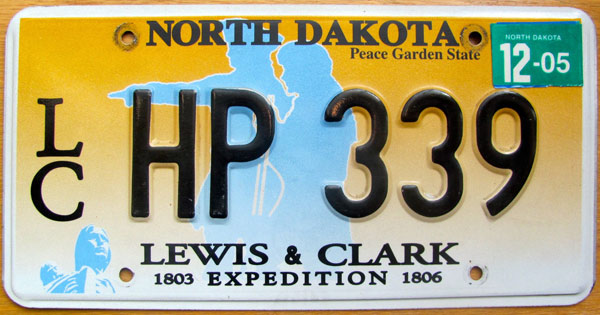 2002-2009 issue.
2002-2009 issue. 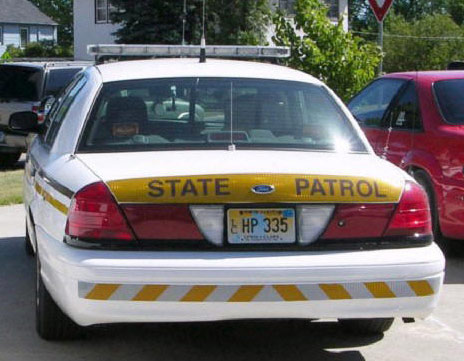
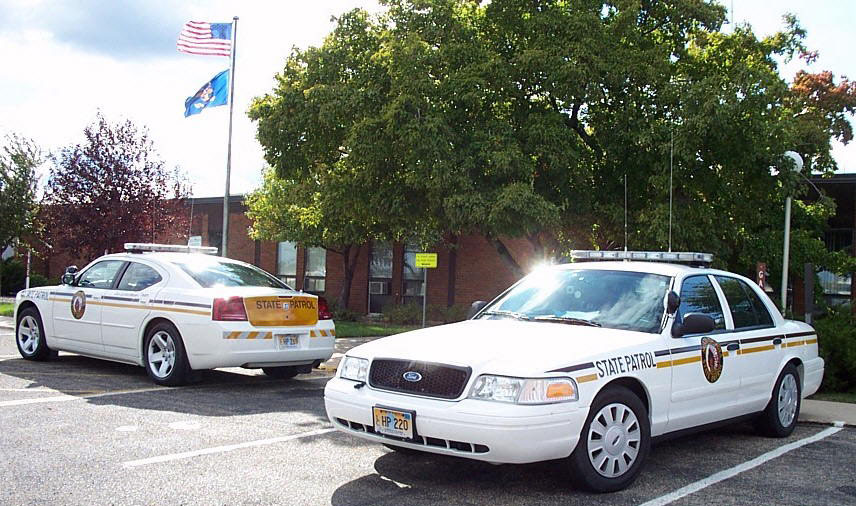
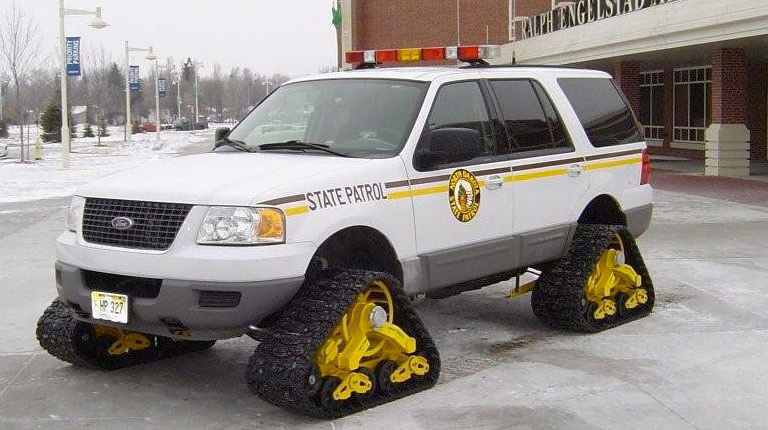
2010 marked the 75th Anniversary of the North Dakota Highway Patrol. The occasion was marked by the issuance of special diamond anniversary license plates for the marked NDHP fleet.
Just like the 50th Anniversary plates, the 75th Anniversary NDHP plates were issued in triplicate. The two plates issued to the patrol vehicle had an embossed badge/radio number preceded by a stacked HP prefix. The plate had a reflective background with gold fading to white in the center and fading back to gold towards the bottom. PEACE GARDEN STATE is silkscreened along the top of the plate between the upper mounting holes. 75th Anniversary is silkscreened in black between the lower mounting holes. A fully stylized graphic representing the NDHP's 75th Anniversary occupies the left portion of the plate.
The patrol car issues also had a black over reflective white decal in the upper right corner that was inscribed with OFFICIAL (over) VEHICLE.
The third plate was the "souvenir plate" that was identical to the "on duty" plates with the exception of only having the badge/radio number WITHOUT the stakced HP prefix and NO decal saying OFFICIAL VEHICLE.
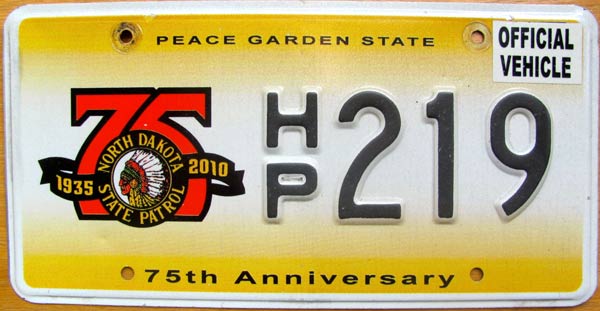 2010-2015 issue. Diamond Anniversary
2010-2015 issue. Diamond Anniversary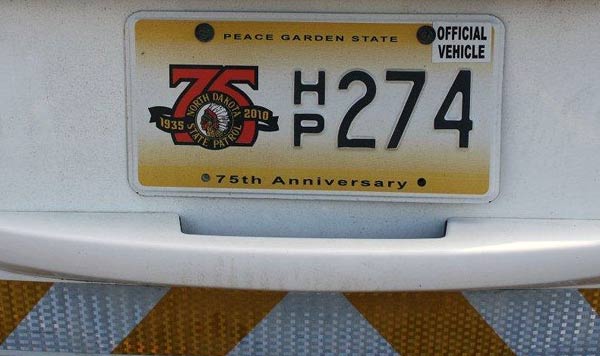 (Courtesy Jim Benjaminson)
(Courtesy Jim Benjaminson)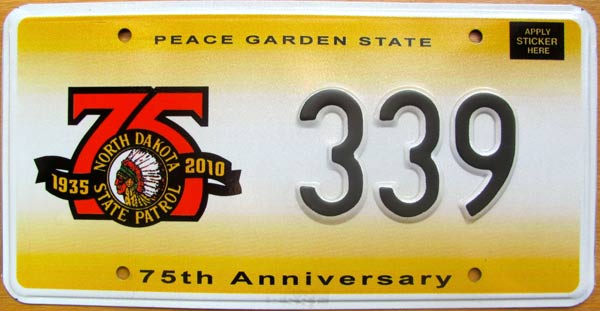 2010-2015 issue. Diamond Anniversary.
2010-2015 issue. Diamond Anniversary.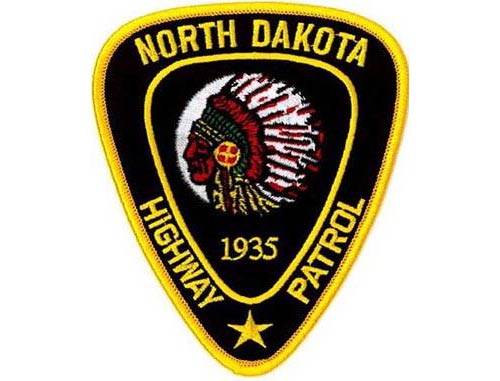
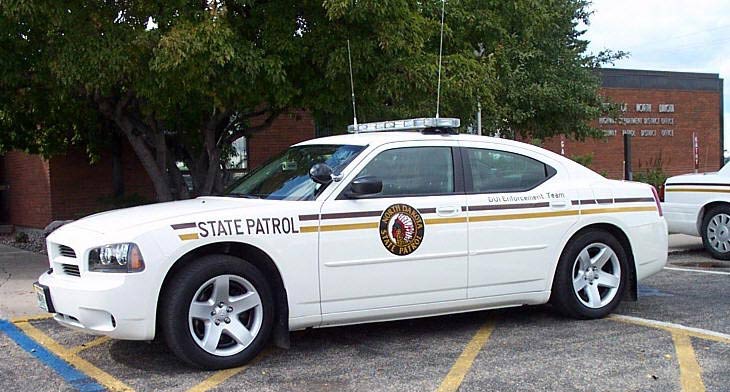
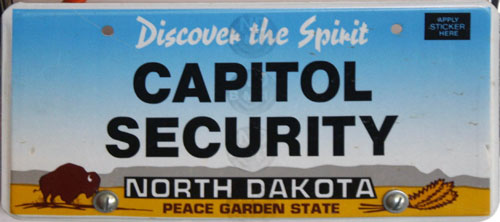 1988-2014 Capitol Security issue.
1988-2014 Capitol Security issue.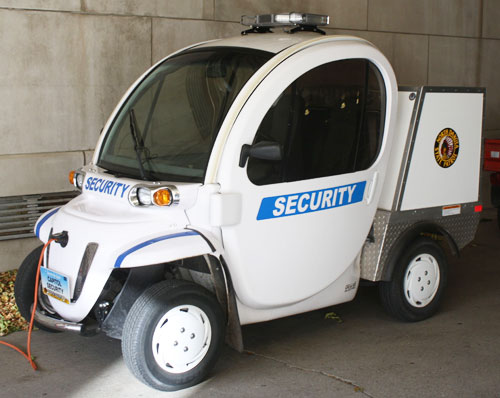 The Ride
The Ride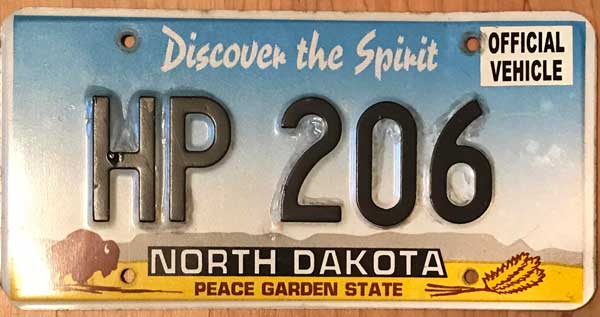 1988-2014 issue.
1988-2014 issue.
In November of 2015, the North Dakota Highway Patrol released a new license plate design for their marked fleet. The plate is entirely silkscreened with no character embossing. It features black silkscreened characters with the HP prefix followed by a number of 3 digits over a sky blue background showing a setting sunset over a mountain range at the bottom of the plate. PEACE GARDEN STATE is screened in white frontier-style font in the bottom left corner of the plate and a detailed buffalo occupies the bottom right corner. The top center of the plate has the word LEGENDARY in small black font over NORTH DAKOTA in larger burnt orange frontier font outlined in black. There are three wheat sheaf sprigs framing the state name on each side just inside the upper mounting holes. A white decal occupies the upper right corner of the plate with OFFICIAL over VEHICLE to authenticate the plate's use on duty.
My thanks to Jim Benjaminson for the timeliniess of this information.
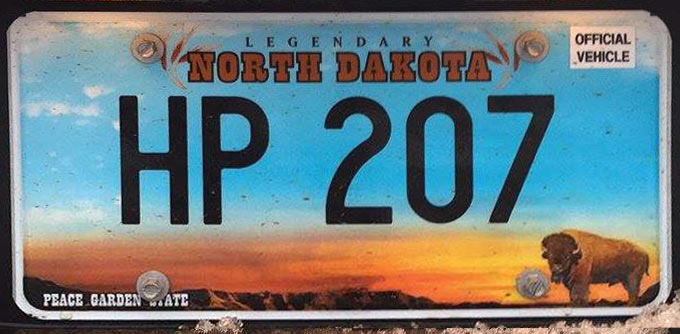 2015-current issue.
2015-current issue. 
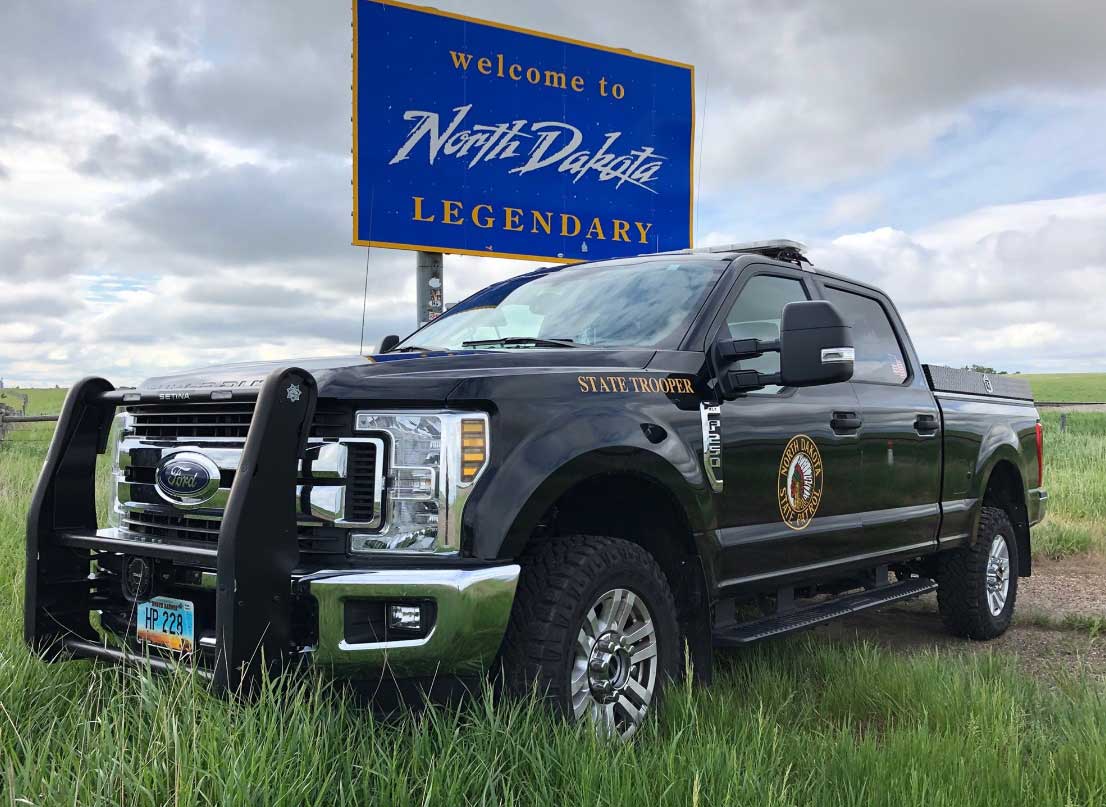 HP 228 (2022)
HP 228 (2022)There was apparently only one motorcycle used by the NDHP for 1938 through 1940, however there is no historical data or photographs of any motorcycle use by the Patrol.
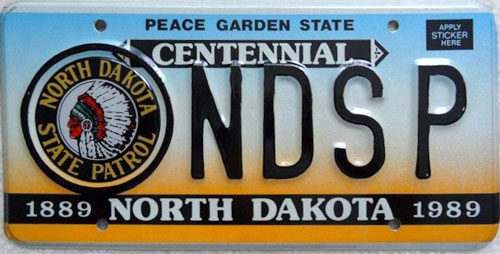 1989 prototype/promotional plate.
1989 prototype/promotional plate.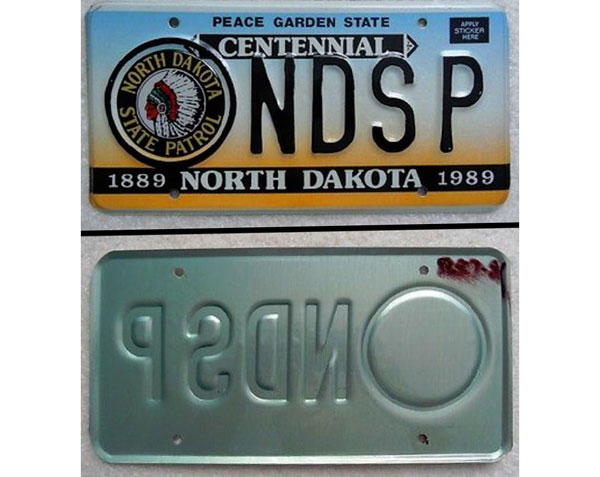
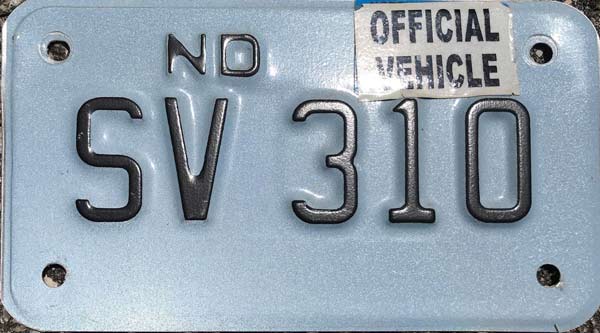 Special Vehicle.
Special Vehicle.